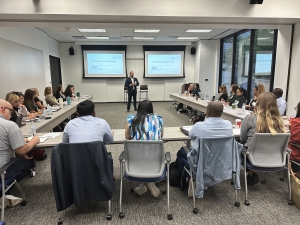
LEFT to RIGHT: Leslie Beyer, PESA; John Daniel, Simmons Energy; Marie Caekebeke, Schlumberger; Jennifer Cutaia, Baker Hughes, a GE company; Valerie Banner, Exterran; Jock Pool, Oceaneering; Sarah Teslik, Joele Frank, Wilkson, Brimmer, Katcher
PESA’s ESG Committee held a luncheon discussion on the basics of Environmental, Social and Governance (ESG) on May 15 at Schlumberger in Houston. The panel discussion included experts from Member Companies who oversee ESG reporting for their business, as well as top analysts.
Panelists included Jennifer Cutaia, Vice President, Corporate Responsibility & Global Community Impact, Baker Hughes, a GE company; Sarah Teslik, Partner, Joele Frank, Wilkson, Brimmer, Katcher; Marie Caekebeke, Director Global Sustainability, Schlumberger; and John Daniel, Managing Director and Senior Research Analyst, Simmons Energy, a Division of Piper Jaffray.
The ESG acronym is quickly becoming a critical part of oilfield lexicon, but many companies are just beginning to understand the term. ESG criteria include a company’s impact on climate change or carbon emissions, water use or conservation efforts, anti-corruption policies, board member diversity, human rights efforts and community development. It is also a set of standards for a company’s operations that socially conscious investors use to screen potential investments.
INVESTOR INTEREST
The panelists each had unique perspectives on the issue. Daniel shared a story about his recent trip to Zurich where he met with investors and in every meeting the subject of ESG was raised. Daniel sees this investment trend shifting to the United States and encouraged attendees to focus on this issue sooner rather than later.
Cutaia and Caekebeke shared the reporting structures of their respective companies. Cutaia advised that companies must be transparent, and information must be easily accessible on the company’s website. Caekebeke agreed noting that investors would rather get their information from the company’s website as opposed to an outside source. Cutaia recommended that legal compliance be included in the ESG team, and that ESG teams work with Investor Relations to help root out deficiencies in the company.
Caekebeke commented that while safety and diversity will always be important measurements for companies, she sees supply chain transparency as the next hurdle in this process. Daniel agreed noting that operators will care about their vendors’ ESG plans when they are required to report on emissions from their well sites. Caekebeke also encouraged attendees to put a code of conduct in place not just for employees but also for vendors.
RATINGS AGENCIES
Teslik, who is a leading expert in corporate governance and investor relations, shared her views on the rating agencies that investors look to for information on publicly-held companies. While these agencies send out questionnaires for companies to submit for a rating, Teslik encouraged attendees not to fill out the questionnaires. Instead, she recommended companies place the same information on their websites where it is accessible to everyone.
She also advised use of a materiality matrix to identify ESG variables and shared that Sustainability Accountability and Standards Board (SASB) has a helpful list of questions that can be answered for investors. She encouraged the service companies to tout their innovations because that technology is helping the operators look good to investors.
For more information about PESA’s ESG Committee contact Tim Tarpley, Vice President Government Affairs for more information.




